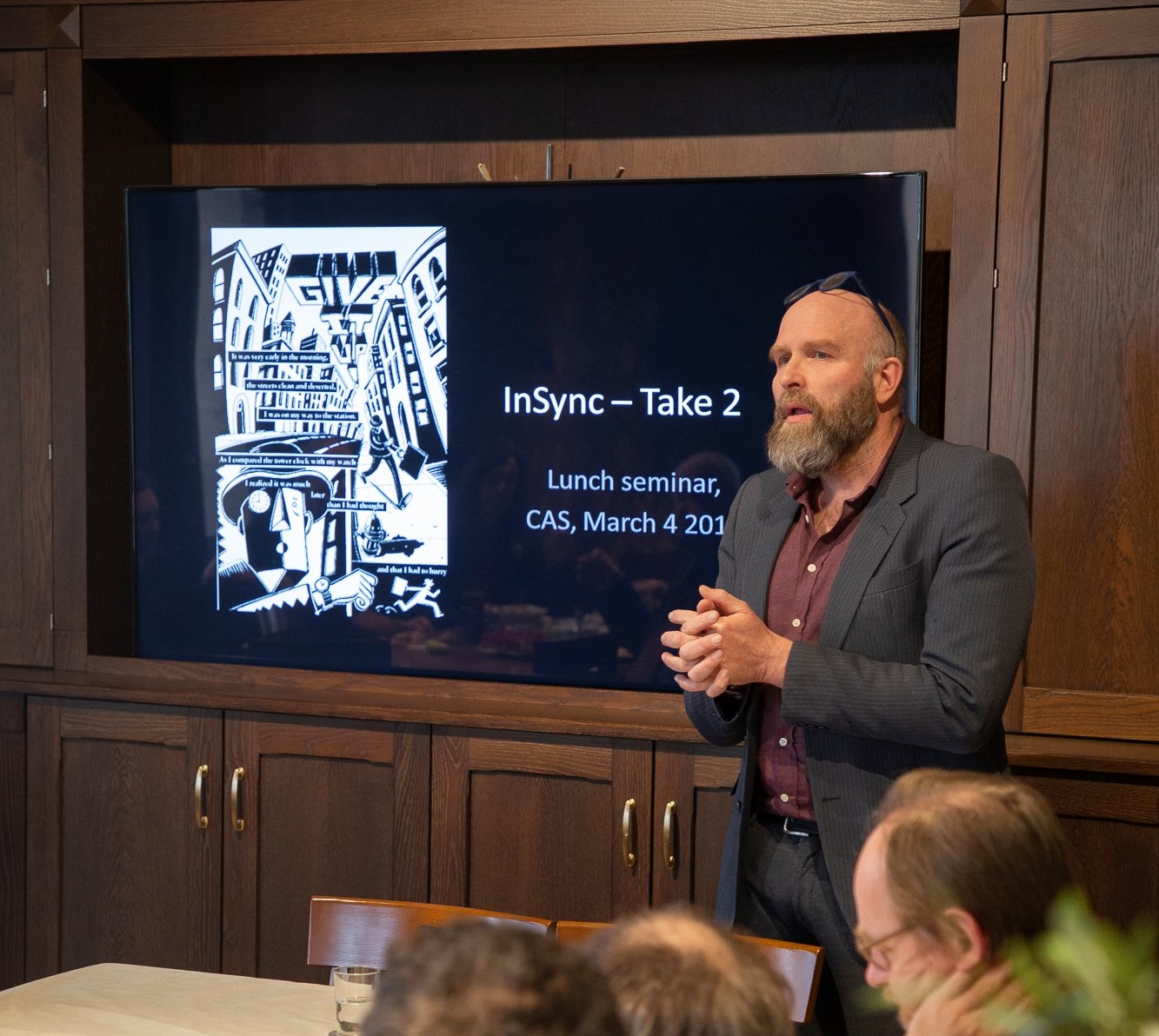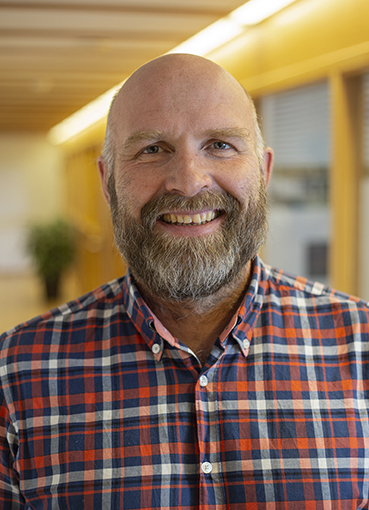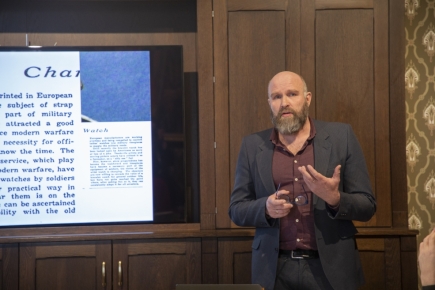Alumnus of the Month: Helge Jordheim

Back in 2018/2019, Helge Jordheim led the CAS project In Sync: How Synchronization and Mediation Produce Collective Times, Then and Now together with professor Espen Ytreberg. The project aimed to explore how social collectives are formed through mediated synchronization, using a variety of communicative genres carried by different media.
The project investigated how different and often conflicting time frames and temporal regimes are adjusted and adapted in order to form a collective and shared time through the use of a set of media, both printed and electronic, both analogue and digital. The project focused on the close connection between synchronisation and mediation, studying it both across time, from the 18th century until today, and across space, in different cultural and geographic contexts.

Congratulations on being awarded the 'Gad Rausings pris för framstående humanistisk forskargärning'! Can you tell us more about your research in the field of cultural history and your project 'In Sync: How Synchronization and Mediation Produce Collective Times, Then and Now' which you led in 2018/2019?
— I started out as a historian of 18th-century German literary and political culture. Then my interest in conceptual history and not least concepts and experiences of time took me into other spaces and periods. For the least ten years, I have tried to understand how people and societies exist in multiple times, at the same time, as it were. In order to find coherence, stability, and meaning, these times need to be adapted and aligned with each other, or synchronized, as we like to put. This is what the project Espen and I were directing at CAS in 2018/2019 was about: How do people use different kind of media – textual, visual, digital – to bring about shared collective temporal experiences, practices, and frameworks
What were the main findings of your CAS project, and how do they contribute to the broader field of humanities and social sciences?
— Somewhat simplified, I think that our main findings had to do with how difficult it is for people to bring about a shared time, within which they can live and act. Many of our studies, by both junior and senior scholars, discovered and explored what we called non-synchronicities, or rather, moments of temporal conflict or instability – for instance, when computer technologies operate at speeds that by far exceeds human comprehension, or when unprecedented events, like pandemics, or terror attacks, disrupt the flow of time and create a disconnect between pasts and futures, or when ideas about technological and industrial progress destroy lives and livelihoods in the colonial spaces of the world, such as Greenland and Suriname.
Our main contribution to the humanities and social sciences, may be even to the natural sciences, is the way we question the universality, singularity, linearity, and continuity of time. Instead, we focus on the different ways in which times exist, emerge, and are made. Since Newton, Western sciences have tended to think of time as a dimension of the universe, a container, into which things can be placed in order to make sense of them. This idea was then questioned by Einstein’s theory of relativity. But what if we think about time as something that emerges in situations, lives, events, practices, and technologies – that a clock doesn’t measure time, but produce it, to take the simple and most obvious example. One of my own experiments while we were at CAS was to explore how traffic jams produce a specific kind of time, which has come to dominate modern societies – disruptive, chaotic, but also shared and social, radically different from the dream of the open highway, on which we are free to go wherever we want. Furthermore, a more complex, multi-dimensional, multi-scalar concept of time is necessary to think about climate emergency, and the fact that we might have entered a new geological epoch, called the Anthropocene. So many different times enter into this idea. It is crucial that we are able to recognize them and make them visible for everyone.
How did you select the historical materials used in the study, and what was the reasoning behind the selection?
— Our project was a conceptual one. It was based on an idea –how we use media to synchronize ourselves and produce collective times – and a set of theories and concepts, rather than a specific material. Hence, we invited all our fellows and guests to bring their own historical materials to the table, and work with them within the framework that project offered. In other words, the coherence of the project was more theoretical, than material. Among the sets of materials that were brought into the group and that we discussed and analyzed together, were Norwegian stave churches, computer clocks, 19th-century German historiography, extractivism on Greenland, modernist film, large-scale infrastructures in the Dutch colonies, as well as in the metropole, Norwegian whaling, the 22 July terror attacks, and much more. In all these cases, an analysis based on multiple times and synchronization brought crucial new insight.

Can you explain how the interdisciplinary approach used in this project helped in achieving the main objective?
— Time doesn’t have a discipline, does it? Some disciplines deal with time up-front, like history or physics, whereas other take time more for granted, as a premise for the work they do. Our goal to relativize time, and show how time is many different things, wouldn’t have been possible without an inter-disciplinary perspective. To understand the specificity of a particular form of time, be it political, aesthetic, or scientific, we need to understand it in a continuum with other times, which have other scales and are inhabited by other life forms. I think the moment when we fully understood the importance of interdisciplinarity was when we invited Jørgen Sugar, from the Moser-team at NTNU, to discuss with us his research on time-cells in the brain, based on experiments with mice. Although we had a hard time understanding all the procedures, the overlap in concepts and theories was stunning.
CAS’ mission is to further excellent, fundamental, curiosity-driven research. Why is fundamental research important, do you think?
— In general, if we limited ourselves to only search for knowledge that have an immediate, already defined application, many of the most important elements of research will be lost: imagination, exploration, curiosity, radical innovation. In addition, in an ever-more unstable world, where crisis seems to have become the new norm, the only thing we can be sure about is that we cannot know what kind of knowledge we will need in the future, both in the long-term and in the short-term. But when we need it, we’ll probably need it badly, and at once.
In what way, if at all, did your year at CAS affect your research career?
— For me, research is about finding the right people, building good teams. I have always seen scholarship as a collective endeavor. In other words, CAS was the ideal environment – an institution dedicated to exactly what for me is the essence of research: exchange of ideas, conversation, discussion. At CAS, I had the opportunity to realize these ambitions under the best possible circumstances: a great venue, solid funding, and not least the best possible staff, who were all so diligent, helpful, friendly, and not least, fun! All the people that were invited profited greatly from all of this in their own work, as can be seen from the publications that have followed. For me, personally, CAS gave me time to develop and test new ideas, in a friendly and engaging environment, which I have since taken into articles and books. Some of these are ideas I hadn’t dared to think, experiments I hadn’t dared to try out, if I hadn’t had my CAS fellows and colleagues to offer criticism, suggestions, and advice.
Were there any unexpected challenges that arose during the project, and if so, how were they addressed?
— My great friend Espen and I shared an office – to have more room for fellows. That was absolutely wonderful – as long as we sat around chatting. But when we agreed to go back to work, it would only take seconds before he was happily hammering away at his computer, whereas I was struggling to collect my thoughts, remember what I was writing about, find the thread of my thinking, avoid checking emails etc. It drove me crazy! The only way to address it was for me to become a more effective writer, which I think I did, at least to a certain extent. Today, when I am procrastinating, I can always hear Espen’s hammering.
What are you currently working on?
— I am currently on sabbatical in the US, with a Fulbright scholarship, at Wesleyan University, where I have great colleagues and friends. While I am here, I try to finish three books, which are all time-books, in different ways, and as such all were conceived during the CAS year: a Norwegian trade book about Berlin, as a city of memory, trauma, ghosts, and angels; an more academic, English-language book about 17th- and 18th-century concepts of time, in history books, encyclopedias, maps, and novels; and a collected volume from the NFR-project that was kicked off while we were at CAS, called Lifetimes.
What do you remember most about your stay at the Centre?
— I think that has to be the workshops in that absolutely wonderful upstairs room, where we also had lunches. It was like sitting in a tower, high above the everyday trivialities. In that room, there were moments of conversations, arguments, ideas, critical interventions that are absolutely unforgettable. In my head, I can still see and hear them.
What advice would you give to future CAS project leaders?
— That’s easy: Bring junior scholars, PhDs and postdocs! They contribute so much to the energy and life of the group and the conversations. But if you do, remember that bringing together a group consisting of very senior, very established scholars, and more junior, less established and often less self-assured ones, might take some extra attention and work from the group leaders. But it is absolutely worth it!
Read more about the CAS project In Sync: How Synchronization and Mediation Produce Collective Times, Then and Now here >
Read more about the 'Gad Rausings pris' here >
This interview was first published in the CAS newsletter. Sign up here to get the latest news from the Centre delivered directly to your inbox every month!